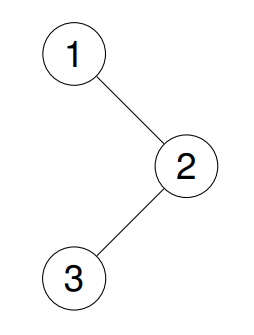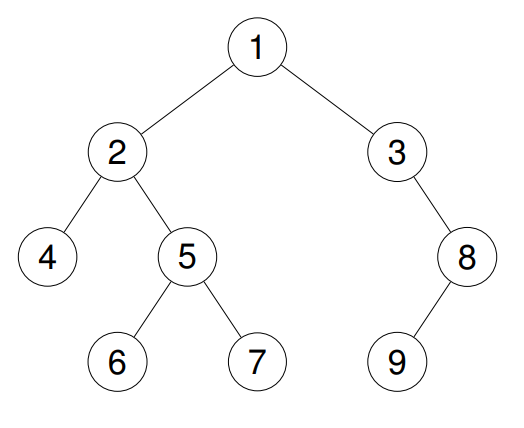94. Binary Tree Inorder Traversal
Description
Given the root of a binary tree, return the inorder traversal of its nodes’ values.
Example 1:
- Input: root = [1,null,2,3]
- Output: [1,3,2]
- Explanation:

Example 2:
- Input: root = [1,2,3,4,5,null,8,null,null,6,7,9]
- Output: [4,2,6,5,7,1,3,9,8]
- Explanation:

Example 3:
- Input: root = []
- Output: []
Example 4:
- Input: root = [1]
- Output: [1]
Constraints:
- The number of nodes in the tree is in the range
[0, 100]. - -100 <= Node.val <= 100
Follow up: Recursive solution is trivial, could you do it iteratively?
Submitted Code
# Definition for a binary tree node.
# class TreeNode(object):
# def __init__(self, val=0, left=None, right=None):
# self.val = val
# self.left = left
# self.right = right
class Solution(object):
def inorderTraversal(self, root):
"""
:type root: Optional[TreeNode]
:rtype: List[int]
"""
def traverse(node, result): # 재귀호출로 중위순회를 하는 함수
if node is not None: # null로 입력받은 노드를 출력해보면 None 값을 가짐
traverse(node.left, result) # 왼쪽 서브트리 방문
result.append(node.val) # 현재 노드 값 추가
traverse(node.right, result) # 오른쪽 서브트리 방문
result = []
traverse(root, result)
return result
Runtime: 3 ms | Beats 3.88%
Memory: 12.47 MB | Beats 36.88%
재귀 호출을 사용했다. result에 값을 계속 저장하기 위해 재귀 호출하는 함수를 따로 만들어야 했다. 효율이 좋은 방식은 아니지만 이진 트리를 파이썬으로 구현하는 방법이 익숙하지 않아서 구조 이해를 목표로 했다.
root = [1,null,2,3]
1
/ \
n 2
/ \
3 n
traverse(root=TreeNode(1), result=[])
↳
traverse(node.left=None, result=[])
↳
traverse(node=None, result=[])
↓
아무 작업 없이 리턴
↓
result.append(1)
↓
traverse(node.right=TreeNode(2), result=[1])
↳
traverse(node=TreeNode(2), result=[1])
↳
traverse(node.left=TreeNode(3), result=[1])
↳
traverse(node=TreeNode(3), result=[1])
↳
traverse(node.left=None, result=[1])
↳
traverse(node=None, result=[1])
↓
아무 작업 없이 리턴
↓
result.append(3)
↓
traverse(node.right=None, result=[1, 3])
↳
traverse(node=None, result=[1, 3])
↓
아무 작업 없이 리턴
↓
result.append(2)
↓
traverse(node.right=None, result=[1, 3, 2])
↳
traverse(node=None, result=[1, 3, 2])
↓
아무 작업 없이 리턴
result= [1,3,2]
Other Solutions
1st
class Solution:
def inorderTraversal(self, root: Optional[TreeNode]) -> List[int]:
res = [] # 결과 저장 리스트
stack = [] # 스택 리스트
while root or stack: # root가 None이고 스택도 비었으면(더이상 노드가 없음) 종료
while root: # 현재 root가 None이면 종료
stack.append(root) # 노드를 스택에 저장
root = root.left # 현재 root를 왼쪽 자식으로 이동
root = stack.pop() # 스택에서 노드를 꺼내서 현재 노드를 처리
res.append(root.val) # 꺼낸 노드의 값을 결과에 추가
root = root.right # 현재 root를 오른쪽 자식으로 이동
return res
time complexity: 𝑂(𝑛)
space complexity: 𝑂(𝑛)
스택으로 중위 순회를 구현하는 답안이다. 시간 복잡도와 공간 복잡도는 재귀 호출 방식과 같지만, 트리의 크기가 커지면 생길 수 있는 오버헤드가 문제가 없기 때문에 훨씬 더 효율적이었다.
2nd
class Solution:
def inorderTraversal(self, root: Optional[TreeNode]) -> List[int]:
# If the current node is None (base case), return an empty list
if not root:
return []
# Recursively get the inorder traversal of the left subtree
left_tree = self.inorderTraversal(root.left)
# Recursively get the inorder traversal of the right subtree
right_tree = self.inorderTraversal(root.right)
# Combine the results: left subtree values, current node value, and right subtree values
return left_tree + [root.val] + right_tree
제출했던 코드보다 더 간결하고 이해가 쉬운 답안이어서 참고했다.
root = [1,null,2,3]
1 / \ n 2 / \ 3 n root = 1 → [] + [1] + [우측 순회] root = 2 → [좌측 순회] root = 3 → []+[3]+[] root = 2 → [3] + [2] + [] root = 1 → [] + [1] + [3, 2]
result= [1,3,2]



Leave a comment